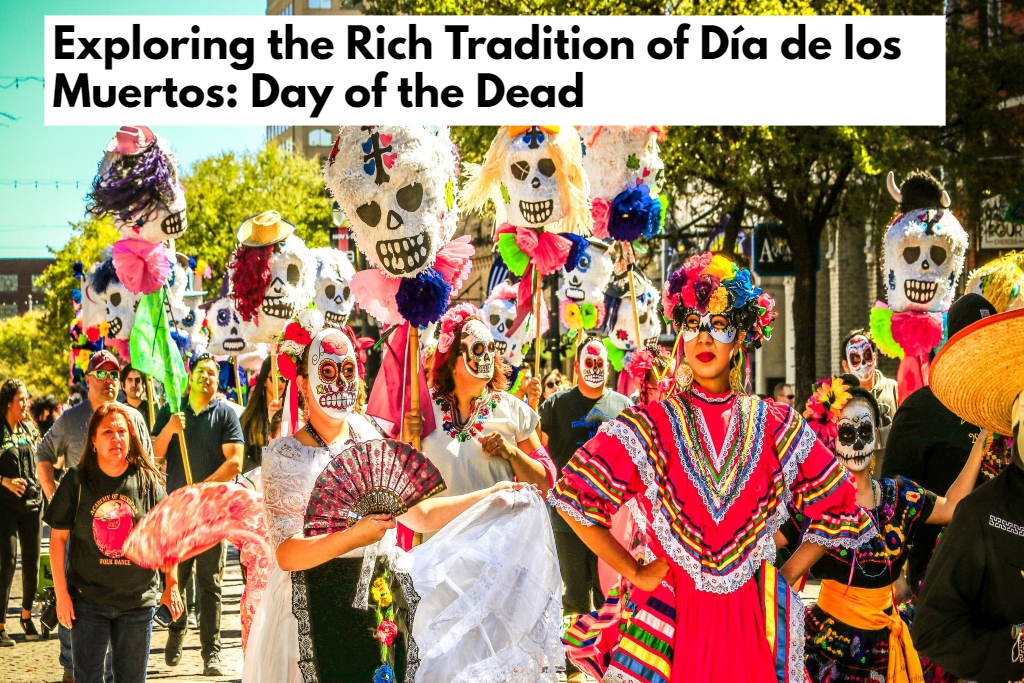Día de los Muertos, or the Day of the Dead, is a captivating and vibrant Mexican holiday that stands as a beautiful blend of ancient Aztec traditions and Catholicism. Celebrated on November 1st and 2nd, it’s a time when families come together to honor their deceased loved ones, believing that their spirits return to the world for a brief reunion. This article delves into the rich and fascinating traditions of this festival, from the creation of altars to the delectable Mexican cuisine that plays a central role.

Day of the Dead-The Origin and Significance
Día de los Muertos has deep historical roots that trace back to the ancient Aztecs. When the Spanish arrived in Mexico in the 16th century, they encountered this indigenous celebration and merged it with their own Catholic traditions. This fusion of cultures gave birth to the modern form of the Day of the Dead.
A Time for Reunion
At its core, Día de los Muertos is a time for families to come together, both the living and the deceased. It’s believed that the spirits of the departed return to the earthly realm during this period, creating an opportunity for a joyful reunion with their loved ones. This celebration is not one of mourning but of remembrance, love, and festivity.
Altars of Remembrance
One of the most distinctive aspects of the Day of the Dead is the creation of altars in homes to honor the deceased. These altars are beautifully adorned with various items, each carrying its own symbolism. The purpose is to create an inviting space for the spirits to visit.
Offerings and Decorations
Altars are typically adorned with items such as candles, marigold flowers, and sugar skulls. Candles are believed to guide the spirits, marigold flowers are considered the flowers of the dead, and sugar skulls are intricately decorated confections symbolizing deceased individuals.
Families also place photos of their loved ones on the altar and include their favorite earthly possessions like soda, candies, or personal mementos. These offerings are meant to provide comfort and sustenance to the returning spirits.
Traditional Foods
No celebration in Mexico is complete without a feast, and Día de los Muertos is no exception. Traditional Mexican dishes take center stage during this time.
Tamales
Tamales, delicious pockets of masa (corn dough) filled with various ingredients, are a staple of Day of the Dead celebrations. They come in different flavors, from savory to sweet, and are often enjoyed by families as they gather around the altar.
Mole
Mole is another essential dish during this festival. This rich and flavorful sauce, which varies by region, is often served with chicken or turkey. Its deep, complex flavors are a symbol of the depth of the celebration.
Champurrado
To warm the hearts and spirits, many partake in champurrado, a Mexican hot chocolate thickened with corn flour. It’s a comforting and traditional beverage that perfectly complements the array of flavors and textures on the Day of the Dead menu.
Pan de Muerto
An absolute highlight of the Day of the Dead culinary experience is “pan de muerto,” or the “bread of the dead.” This distinctive Mexican bakery item is a seasonal delicacy, available only during this time of the year. The bread is often shaped like “muertitos” (little dead people), angels, and skulls. The flavor and preparation of “pan de muerto” distinguish it from the more common “pan dulce” (sweet bread) consumed throughout the year.
The Heart of the Celebration: La Frontera Bakery
In the heart of Redmond, Washington, you can find the La Frontera Bakery, where the spirit of Día de los Muertos comes to life. Moises Maldonado, a 33-year-old baker, is busy crafting a variety of traditional Mexican bakery items, including the coveted “pan de muerto.” Customers eagerly fill their trays with these puffy, delicately prepared loaves to adorn their altars or savor with their families.
Maldonado describes the “bread of the dead” as a symbol that connects them to their ancestors and the beautiful tradition they carry on year after year. It’s not just a delicious treat; it’s a meaningful link to the past and a way to honor those who have passed.
“The living eat more of it than the dead,” Maldonado chuckles as he shapes dough into scrumptious creations.

Personal Touch: Honoring Loved Ones
Gaby Herrera, who works alongside Maldonado at the bakery, has her own unique way of honoring her late father. While she doesn’t place “bread of the dead” on her altar, she includes items she knows her father’s spirit will appreciate.
Herrera’s tradition is to leave her altar up for the entire month of November, ensuring that her father’s spirit is remembered and cherished. In Mexico, the holiday is celebrated with vibrant music and other festivities, reminiscent of the heartwarming scenes in the animated movie “Coco.”
In Conclusion
Día de los Muertos, or the Day of the Dead, is a celebration of life and a testament to the enduring connections between the living and the departed. It’s a festival that beautifully blends ancient traditions with the customs of a new world. With its vibrant altars, delicious traditional foods, and heartfelt remembrance, this celebration is a time to cherish the memories and honor the spirits of loved ones.
This article has explored the deep-rooted traditions of this Mexican holiday, giving you a glimpse into the essence of Día de los Muertos. We hope it has not only informed you but also inspired you to embrace the beauty of this cultural celebration, whether by creating your own altar, trying traditional Mexican cuisine, or simply taking a moment to remember and honor your loved ones.

